Any day now the mulberries will start raining down. I first encountered them in a Boston neighborhood my sister lived in during college. The beautiful blackberry-like fruits stained the sidewalks and porches and stuck to people's shoes. One June we picked a mess of them and made a cobbler, and I couldn’t get over the abundance.
A few years later I planted a mulberry tree on our back hill. It’s grown quickly—already it’s big enough to climb and twenty feet tall with broad, glossy green leaves. It self-pollinates, which means we don’t need another, and the berries start forming in early June. By the end of the month the first mulberries are ripe—and the juicy, deep red, almost black berries keep coming steadily through August. Even with a stream of kids climbing into the branches to feast, and neighbors and friends stopping by to pick, and our chickens and the birds and raccoons taking their share—the tree still produces more than we can eat fresh.
So the past few years we’ve started experimenting—trying to learn how best to preserve the harvest. First I tried drying the berries—there’s a granola I like that has dried mulberries in it, and I figured maybe I could make some myself. So I spread the extra fruit on a sheet covered with a screen to keep off the flies and let it dry in the sun. It worked well, but only when the weather was perfect—not too humid with a string of blue sky days, which is unusual when the berries are at their peak in July.
So the next summer, I tried freezing them. I wasn’t sure how the texture would hold up or what I would use the frozen berries for—but I filled old yogurt containers and peanut butter jars and before I knew it I had frozen 40 pints.
That winter we were rich with mulberries. We tried them in everything—mulberry breads and muffins and cakes and pie—but it ended being the simplest use we liked best. Mulberries became our smoothie fruit—the thing we blended together with kefir or yogurt and a few pieces of frozen banana to make a quick breakfast or an afternoon snack.
Freezing has turned out to be the key to capturing the abundance of the mulberry tree. Every year now we freeze at least 30 to 40 pints, heading out every other day during mulberry season with our berry buckets around our necks and spending ten or fifteen minutes after breakfast filling them up. We drop plenty, and the chickens flock beneath the tree, and if we stop picking for too many days the fruit flies come, so by August we’re begging friends to come and pick their fill, just to give us a break. The abundance still amazes me. I’ve never met a fruit tree as generous as the mulberry.
The trees come in three main varieties: red, white, and black mulberries. Red and black mulberries are the tastiest, and red mulberries are native to North America. Their range extends from Massachusetts south to Florida and west all the way to Iowa and Texas. In the past we’ve been at the far northern tip of their range, but the climate is changing. A friend of mine talks about planting trees like this as a form of assisted migration, helping big, slow-moving plants escape the heat. That’s not why we planted our mulberry. But it’s nice to think of the relationship that way—of our lone tree as an outpost for future mulberries, and of this assisted migration as a form of reciprocity.
—
EVERYDAY MULBERRY SMOOTHIE
Serves 1
Think of this as a guideline, not an absolute. Between the abundance of the mulberries and the abundance of tired and half eaten bananas around here, this smoothie has become our go-to. Sometimes I use milk, but I prefer plain, unsweetened kefir for its tanginess. Yogurt works too.
As a bonus, any leftover smoothie can also be frozen in popsicle molds for an excellent homemade smoothie pop!
2/3 cup frozen mulberries
roughly 1/2 frozen banana, broken into pieces
2/3-3/4 cup whole milk or kefir
Combine everything in a Magic Bullet, blender, or food processor and whiz until smooth. Drink at once.
—
MULBERRY PIE
Is there anything better than baking a pie in the middle of winter from summer fruit? I first tried my hand at mulberry pie the spring of the 2020, in the midst of the COVID-19 pandemic. We had plenty of berries and plenty of time, so we experimented until we got it just right.
Pie crust of your choice
5 cups berries
2/3 cup sugar
1 Tbs lemon juice
4 Tbs corn starch
Preheat the oven to 400 degrees F. Roll out the bottom pie crust and drape it over a 9-inch pie plate. In a large bowl mix the berries, sugar, lemon juice, and cornstarch. Spoon this filling into the bottom crust. Roll out the top crust and cut it into strips to weave a lattice over top of the fruit. When this is done, trim the edges of bottom and top crusts so they have about 1-inch of overhang. Roll this overhang onto the rim of the pie plate, crimping as you go. Bake for 30 minutes, then turn the oven down to 350 degrees F and bake another 20-30 minutes, until the fruit is bubbling and the crust is golden. Cool to room temperature, then serve with vanilla ice cream.











